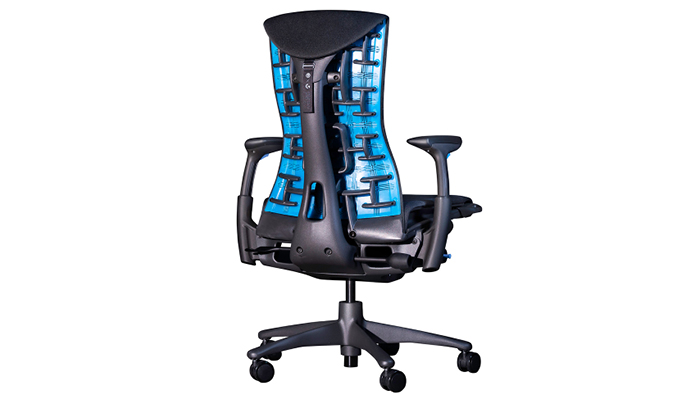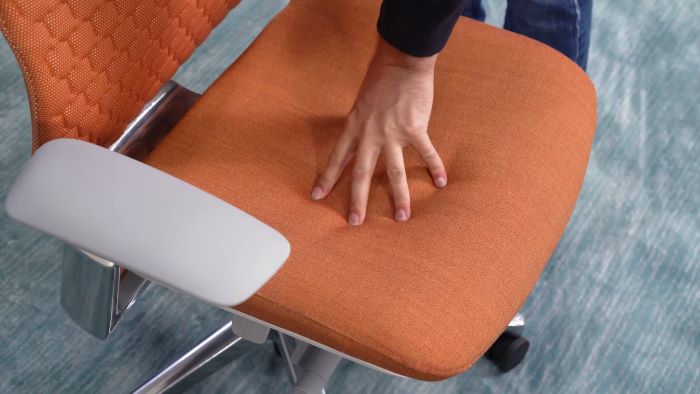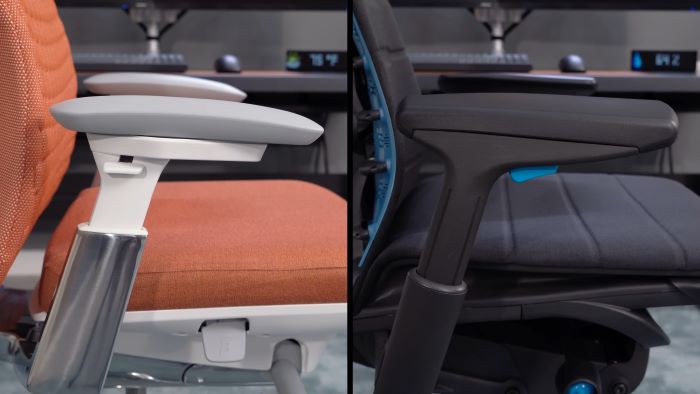Finding the perfect office chair can be a challenge. After testing hundreds of chairs, I have found only two that have made it into the S tier for me: the Haworth Fern and the Herman Miller Gaming Embody. Both have unique technology and are incredibly comfortable. However, they are not without their flaws. In this article, I will compare the Fern and the Embody, highlighting their strengths and weaknesses.
Full Disclaimer: We are an office furniture dealer and sell some of the products we review. To learn more about the products we sell, our review process and why you can trust us, please visit: Why we’re different. Who is BTOD.com and The Breakroom Blog?
Fern vs Embody Links
- The Original Embody
- The Fern Chair
- The Gaming Embody
- Backrest and Recline
- Seat Comfort
- Generous Armrests
1. The Original Embody
To begin, I received my first Embody chair about 4 years ago. At the time, it was the basic model as the gaming version had not yet been released. I was impressed with the chair’s build quality, comfort, and features. There were two aspects that made me consider other options though: the seat and the lumbar support.

The original Embody seat had minimal padding, making it feel firm and sometimes uncomfortable. The backrest also lacked sufficient padding, resulting in a hard lower back support. Despite these drawbacks, I still recognized the chair as a great option, but not the best available.
2. The Fern Chair
Similar to the Embody, my experience with the Fern chair had its ups and downs. The original model had some features that I liked, but there were also a couple of things that made me hesitant to use it: the headrest and the lumbar support. The headrest was hard and had limited adjustability, making it uncomfortable for me.

Additionally, the lumbar support was too aggressive for my personal preference. As a result, I set the chair aside and went back to using my Leap chair. Fast forward a few months, we received a couple of new Fern chairs in different versions. One of them had no headrest or lumbar support, and it featured an upgraded fabric called digital knit.

The absence of the headrest and lumbar support made a huge difference in the chair’s comfort. Moreover, the digital knit fabric provided a softer touch and added an extra layer of padding, enhancing the overall sitting experience.
3. The Gaming Embody
Next, Herman Miller released the gaming variant of the Embody chair. This version included more padding in the seat and back, a different fabric, and copper cooling in the foam. While I didn’t notice much of a difference in terms of cooling, the added foam made a noticeable improvement in comfort. The textured fabric also contributed to a softer feel in the lower back area. These minor changes elevated the Embody chair to S tier for me, alongside the Fern chair.

4. Backrest and Recline
The backrest designs are what really set these chairs apart from the rest of the chairs in the category. Both the Fern and the Embody offer thin, flexible backs that allow for a wide range of movement. They also feature an ergonomic S shape to support the spine.

I do find the Fern’s backrest to be softer and more forgiving, thanks to its four-layer system that creates a pillowy suspended feeling. On the other hand, the Embody’s backrest is slightly firmer. The Fern chair offers the advantage of adjustable lumbar support, while the Embody’s lumbar support remains fixed.
The Fern’s backrest is also slightly taller, providing support for my entire back. In terms of recline, both chairs offer a good range of motion. The Fern has a synchro tilt mechanism that provides a deep recline and smooth operation. Although, the Embody takes the lead in my opinion.

Its Harmonic tilt mechanism allows for effortless use of the entire recline range. Herman Miller chairs have a unique rocking sensation while maintaining an ergonomic position. The Embody also offers independent back angle adjustment, allowing for a fully upright position or a deeper recline.
5. Seat Comfort
I really like both seats, but they offer different experiences. The Fern has a more traditional padded design, with a firm pad that softens over time. It remains supportive without being too hard, even after long hours of sitting. The seat has no hard edges or pronounced contour, making it suitable for various seating positions, including cross-legged.

One drawback is the Fern’s seat, it may not be deep enough for taller individuals. Extending the seat pad all the way out creates a noticeable gap between the seat and backrest, which can be uncomfortable. The Embody is not going to have that issue. It is designed with a pixelated system and a small layer of foam.

This unique design distributes weight evenly across the entire surface of the seat, providing a suspended feeling. The seat feels soft and comfortable, and it is one of the most comfortable seats I have used. Some people just might find the adjustment handles to be clunky and ugly.
6. Generous Armrests
Lastly, the armrests on both the Fern and the Embody chairs offer different features and adjustments. The Embody chair has height and width adjustable armrests, which provide a wide range of customization options. However, it lacks depth and swivel adjustments, which can pose a problem for some users. The lack of depth adjustment affects how close I can get to my desk.

The Fern chair comes with 4-way adjustable armrests, offering a greater range of adjustments compared to the Embody. These armrests accommodate a wider variety of sitting positions and provide more flexibility. The arm caps on the Fern chair are not as soft as those on the Embody, and I prefer the flat design of the Embody’s arms over the rounded tops of the Fern’s arms.
Bottom Line
Ultimately, both the Haworth Fern and the Herman Miller Gaming Embody chairs are exceptional options for office seating. They offer unique features and technologies that contribute to their comfort and support. It’s always a good idea to try out different chairs and find the one that best fits you. Happy Sitting!




